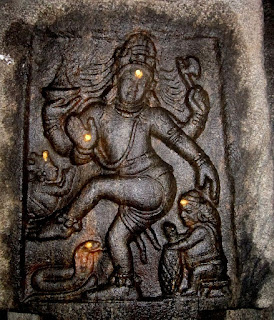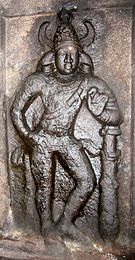 ஒடிசாவின் அசன்பத் கிராமத்தில் கிடைத்துள்ள சத்ருபஞ்சாவின் பதின்மூன்று வரிக் கல்வெட்டு
ஒடிசாவின் அசன்பத் கிராமத்தில் கிடைத்துள்ள சத்ருபஞ்சாவின் பதின்மூன்று வரிக் கல்வெட்டுஒடிசாவில் நாகர் அரசன் சத்ருபஞ்சா (Satrubhanja) பொஆ 261 முதல் 340 வரை
இப்போது ஒடிசா மாநில அருங்காட்சியகத்தில் வைக்கப்பட்டுள்ள அசன்பத் கல்வெட்டு, சத்ருபஞ்சாவை ஆட்சியாளர் எனவும் போர்வீரன் எனவும் விரிவான கண்ணோட்டத்தை அளிக்கிறது. இவர் நாக குலத்தில் அரசர்களிடையே சந்திரனைப் போலப் பிறந்தவர் என்றும், மகாபாரதத்தில் பீஷ்மருக்கு வழங்கப்பட்ட சிறப்புப் பெயரான இரனஸ்லாகின் (போரில் பெருமை கொண்டவர்) என்றும் விவரிக்கப்படுகிறார்.
ஜெனிவாவில் உள்ள CERN (European Center for Research in Particle Physics)
"Hundreds of years ago, Indian artists created visual images of dancing Shivas in a beautiful series of bronzes. In our time, physicists have used the most advanced technology to portray the patterns of the cosmic dance. The metaphor of the cosmic dance thus unifies ancient mythology, religious art and modern physics."
அதாவது, "நூற்றுக்கணக்கான வருடங்களுக்கு முன்பே இந்திய கலைஞர்கள் சிவபெருமானின் நடன கோலத்தை வெண்கலத்தில் வடித்துள்ளனர். நம்முடைய காலத்தில், இயற்பியல் வல்லுனர்கள் மிக நவீன தொழில்நுட்பங்களை பயன்படுத்தி இந்த பிரபஞ்ச நடனத்தினை வருணித்துள்ளோம். இந்த பிரபஞ்ச நடனத்தின் உருவணி மெய்ஞானத்தையும், அறிவியலையும் ஒன்றிணைக்கிறது." என்று அவர் குறிப்பிட்டுள்ளார். மேலும் இது குறித்து அவர் "TAO OF PHYSICS" என்ற புத்தகத்தையும் எழுதியுள்ளார். அந்த புத்தகத்தில் இந்து மதத்திற்கும், இயற்பியலுக்கும் உண்டான தொடர்புகளை அவர் குறிப்பிட்டுள்ளார்.
நடராஜர் 1500 ஆண்டு தொன்மை திருமேனி மத்தியப்பிரதேசத்தில பிரம்மாண்டமானது கிடைத்துள்ளது
ஆகமங்கள் போற்றும் நடராஜர் வடிவம் 1500 வருடம் முந்தையது.
A 1500-year-old dancing Shiva statue has been found in Vidisha district from Madhya Pradesh, which is being claimed to be the world's largest Nataraja statue.
மத்தியப்பிரதேச மாநிலம் விதிஷாவில் 9 × 4 மீட்டர் அளவிலான 1500 வருட பழமையான ஒரே கல்லில் செதுக்கிய நடராஜர் சிலை கிடைத்தது.
A huge statue of Lord Shiva's Nataraja form, about 1500 years old, has been found in Vidisha district of Madhya Pradesh. The statue is 9 meters long and 4 meters wide. Due to its large size, it was left in the ground as a pillar, but recently the state coordinator of INTECH Madan Mohan Upadhyay has revealed the mysterious pillar to be the largest statue of Nataraja.

.jpg)
Avanibhajana Pallaveshwaram Temple
Avanibhajana Pallaveshwaram temple also called Stambeswarar Temple is a Hindu temple dedicated to Shiva, located in the town of Seeyamangalam, Tiruvannamalai district in Tamil Nadu, India. The temple is constructed in Rock-cut architecture by the Pallava king Mahendravarman I (600-630 CE) during the 7th century. The cave temple had later additions from the Chola and Vijayanagar Empire.
One of the pillars has a sculpture of Nataraja, believed to be the earliest representation of the deity in South India. The temple has a small three-tiered rajagopuram, the entrance tower. The temple is declared as a heritage monument and administered by the Archaeological Survey of India as a protected monument. The other side of the hillock houses the Jain beds established in the 9th century during the reign of Ganga King Rajamalla II.
Stambeswarar temple was built during the reign of Pallava king Mahendravarman I (600-630 CE) during the 8th century. It is one of the earliest representations of Rock-cut architecture. The place is called Avanibhajana Pallaveshwaram temple as Avani is one of the titles of King Mahendravarman. Though the image of the lions in the pillars lead to an assumption that the temple might have been possibly been initiated by Simhavishnu, the father of Mahendravarman, the view is not accepted. The inscriptions, accounted in Epigrahia Indica, is written in Sanskrit with Grantha-Pallava alphabet. The inscriptions indicate that it was dug out by Lalitankura, which is similar to that of cave temple in Tiruchirapalli Rock Fort indicating Mahendravarman. The temple had later additions from the Chola and Vijayanagar Empire. The gopuram, the gateway tower is believed to be an addition by the Vijayanagar kings.[1] The other side of the hillock houses the Jain beds established in the 9th century during the reign of Ganga King Rajamalla II.
Nataraja is the cosmic representation of Shiva's different dance forms. The temple has the earliest representation of Nataraja in sculpture. As per Hindu mythology, Shiva is a violent dancer and while he dances, a snake named Karkodaka winds in his legs, leading to Shiva performing the Bhujamgatrasa, the snake fight posture. The sculpture of Nataraja in the temple depicts the posture. Shiva is sported with four hands, with his one of the left hands showing dola hasta posture, parasu in the second left, Abhaya mudra (protecting posture) in the first right hand and fire in the second right hand. Archeologist Dr.R.Nagaswamy believes that the hooded snake at the foot of Nataraja is the proof of Bhujamgatrasa. It is believed that all forms of dance are derived from Natya Sastra by sage Bharatha and Mahendravarma's knowledge of delicate postures are exemplified in the sculpture. He also affirms that by the image Mahendra shows the connection between bhujaṅga trāsita and that the dance of Nataraja, the cosmic form of Shiva leads to the Ananda.
Worship and religious practices
The temple is declared as a heritage monument and administered by the Archaeological Survey of India as a protected monument.[9] Though it is an archaeological monument, the temple is active in worship practices, where the temple priests perform the puja (rituals) during festivals and on a daily basis. The temple rituals are similar to that of other Shiva temples.
300 வருடம் முன் வாழ்ந்த சிறுமணவூர் முனுசாமி எழுதிய நடராஜ பத்து
பாடல் : 1
மண்ணாதிபூதமொடு விண்ணாதி அண்டம் நீ, மறை நான்கின் அடிமுடியும் நீ,
மதியும் நீ, ரவியும் நீ, புனலும் நீ, அனலும் நீ, மண்டலம் இரண்டேழும் நீ,
பெண்ணும் நீ, ஆணும் நீ, பல்லுயிர்க்குயிரும் நீ, பிறவும் நீ, ஒருவன் நீயே,
பேதாதி பேதம் நீ, பாதாதி கேசம் நீ, பெற்ற தாய் தந்தை நீயே,
பொன்னும் நீ, பொருளும் நீ, இருளும் நீ, ஒளியும் நீ, போதிக்க வந்த குரு நீ,
புகழொணா கிரகங்கள் ஒன்பதும் நீ, இந்த புவனங்கள் பெற்றவனும் நீ,
எண்ணரிய ஜீவகோடிகள் ஈன்ற அப்பனே என் குறைகள் யார்க்கு உரைப்பேன்,
ஈசனே சிவகாமி நேசனே எனையீன்ற தில்லைவாழ் நடராஜனே.
பாடல் : 2
மானாட, மழுவாட, மதியாட, புனலாட, மங்கை சிவகாமியாட,
மாலாட நூலாட மறையாட திறையாட, மறை தந்த பிரம்மனாட,
கோனாட வானுலகக் கூட்டமெல்லாமாட, குஞ்சர முகத்தனாட,
குண்டலம் இரண்டாட, தண்டைபுலி உடையாட, குழந்தை முருகேசனாட,
ஞான சம்பந்தரோடு இந்திரர் பதினெட்டு முனி அட்ட பாலகருமாட,
நரைதும்பை அறுகாட நந்தி வாகனமாட நாட்டியப் பெண்களாட,
வினையோட உனை பாட, எனை நாடி இதுவேளை, விருதோடு ஆடி வருவாய்
ஈசனே சிவகாமி நேசனே எனையீன்ற தில்லைவாழ் நடராஜனே.
பாடல் : 3
கடலென்ற புவிமீதில் அலையென்ற உருக்கொண்டு கனவென்ற வாழ்வை நம்பி,
காற்றென்ற மூவாசை மாருதச் சூழலிலே கட்டுண்டு நித்தம் நித்தம்
உடலென்ற கும்பிக்கு உணவென்ற இரைதேடி ஓயாமல் இரவு பகலும்
உண்டுண்டு உறங்குவதைக் கண்டதே யல்லாது ஒரு பயனடைந்திலனே!
தடமென்ற இடி கரையில் பந்தபாசங்களெனும் தாபமாம் பின்னலிட்டு
தாயென்று சேயென்று நீயென்று நானென்று தமியேனை இது வண்ணமாய்
இடையென்று கடைநின்று ஏனென்று கேளாது இருப்பதுன் அழகாகுமோ
ஈசனே சிவகாமி நேசனே எனையீன்ற தில்லைவாழ் நடராஜனே.
பாடல் : 4
வம்பு சூனியமல்ல வைப்பல்ல மாரணம் தம்பனம் வசியமல்ல
பாதாள அஞ்சனம் பரகாய பிரவேசம் அதுவல்ல ஜாலமல்ல
அம்பு குண்டுகள் விலக மொழியு மந்திரமல்ல ஆகாய குளிகையல்ல
அன்போடு செய்கின்ற வாதமோடிகளல்ல அரிய மோகனமுமல்ல
கும்பமுனி மச்சமுனி சட்டமுனி பிரமரிஷி கொங்கணர் புலிப்பாணியும்
கோரக்கர் வள்ளுவர் போகமுனி இவரெலாம் கூறிடும் வைத்தியமல்ல
என்மனது உன்னடி விட்டு விலகாது நிலைநிற்கவே உளது கூறவருவாய்
ஈசனேசிவகாமி நேசனே எனையீன்ற தில்லைவாழ் நடராஜனே.
பாடல் 5:
நொந்து வந்தேனென்று ஆயிரம் சொல்லியும் செவியென்ன மந்தமுண்டோ
நுட்பநெறி அறியாத பிள்ளையைப் பெற்றபின் நோக்காத தந்தையுண்டோ
சந்ததமுன் தஞ்சம் என்றடியைப் பிடித்தபின் தளராத நெஞ்சமுண்டோ
தந்திமுகன் அறு முகன் இருபிள்ளை இல்லையோ தந்தை நீ மலடுதானோ,
விந்தையும் ஜாலமும் உன்னிடமிருக்குதே வினையொன்றும் அறிகிலேனே,
வேதமும் சாஸ்திரமும் உன்னையே புகழுதே வேடிக்கை இதுவல்லவோ
இந்த உலகீரேழும் ஏனளித்தாய் சொல்லு இனி உன்னை விடுவதில்லை
ஈசனே சிவகாமி நேசனே எனையீன்ற தில்லைவாழ் நடராஜனே.
பாடல் 6:
வழிகண்டு உன்னடியை துதியாத போதிலும் வாஞ்சையில்லாத போதிலும்
வாலாயமாய் கோயில் சுற்றாத போதிலும் வஞ்சமே செய்த பொதிலும்
மொழி எதுகை மோனையும் இல்லாமல் பாடினும்
மூர்க்கனேன் முகடாகினும் மோசமே செய்யினும்
தேசமே கவரினும் முழுகாமியே ஆகினும் பழியெனக் கல்லவே தாய்தந்தைக்கல்லவோ
பார்த்தவர்கள் சொல்லார்களோ பாரறிய மனைவிக்கு பாதியுடல் ஈந்த நீ
பாலகனை காக்கொணாதோ எழில்பெரிய அண்டங்கள் அடுக்காய் அமைத்த நீ
என் குறைகள் தீர்த்தல் பெரிதோ
ஈசனே சிவகாமி நேசனே எனையீன்ற தில்லைவாழ் நடராஜனே.
பாடல் : 7
அன்னை தந்தைகள் எனை ஈன்றதர்க்கு அழுவனோ, அறிவிலாததற்கு அழுவனோ
அல்லாமல் நான்முகன் தன்னையே நோவனோ ஆசை மூன்றுக் கழுவனோ
முன்பிறப்பென்ன வினை செய்தேன் என்றழுவனோ என் மூட அறிவுக்கு அழுவனோ
முன்னில் என் வினை வந்து மூளும் என்றழுவனோ முத்தி வருமென்று உணர்வனோ
தன்னை நொந்தழுவனோ உன்னைநொந்தழுவனோ தவமென்னஎன்றழு வனோ
தையலர்க்கு அழுவனோ மெய்வளர்க்க அழுவனோ தரித்திர திசைக்கழுவனோ
இன்னுமென்ன பிறவி வருமோ என்றழுவனோ எல்லாம் உரைக்க வருவாய்
ஈசனே சிவகாமி நேசனே எனையீன்ற தில்லைவாழ் நடராஜனே.
பாடல் : 8
காயாமுன் மரமீது பூ பிஞ்சறுத்தனோ கன்னியர்கள் பழி கொண்டனோ
கடனென்று பொருள் பறித்தே வயிறெறித்தனோ கிளை வழியில் முள்ளிட்டனோ
தாயாருடன் பிறவிக்கென்ன வினை செய்தனோ தந்த பொருள் இல்லை யென்றனோ
தானென்று கர்வித்து கொலை களவு செய்தனோ தவசிகளை ஏசினேனோ
வாயாரப் பொய் சொல்லி வீண்பொருள் பறித்தனோ வானவரை பழித்திட்டனோ
வடவுபோல் பிறரை சேர்க்காது அடித்தனோ வந்தபின் என்செய்தேனோ
ஈயாத லோபியென்றே பெயரெடுத்தனோ எல்லாம் பொறுத் தருளுவாய்
ஈசனே சிவகாமி நேசனே எனையீன்ற தில்லைவாழ் நடராஜனே.
பாடல் 9 :
தாயார் இருந்தென்ன தந்தையும் இருந்தென்ன தன் பிறவி உறவுகோடி
தனமலை குவித்தென்ன கனபெயர் எடுத்தென்ன தாரணியை ஆண்டுமென்ன
சேயர்கள் இருந்தென்ன குருவாய் இருந்தென்ன சீடர்கள் இருந்தும் என்ன,
சித்து பல கற்றென்ன நித்தமும் விரதங்கள் செய்தென்ன, நதிகளெல்லாம்
ஓயாது மூழ்கினும் என்ன பலன் எமனோலை ஒன்றைக் கண்டு தடுக்க உதவுமோ
இதுவெல்லாம் சந்தை உறவென்று தான் உன்னிரு பாதம் பிடித்தேன்.
யார் மீது உன் மனமிருந்தாலும் உன் கடைக்கண் பார்வை அது போதுமே
ஈசனே சிவகாமி நேசனே எனையீன்ற தில்லைவாழ் நடராஜனே.
பாடல் 10 :
இன்னமும் சொல்லவோ உன் மனம் கல்லோ இரும்போ பெரும் பாறையோ
இருசெவியும் மந்தமோ கேளாது அந்தமோ இது உனக்கழகு தானோ
என் அன்னை மோகமோ இதுவென்ன சாபமோ, இதுவே உன்செய்கைதானோ
இருபிள்ளை தாபமோ யார்மீது கோபமோ ஆனாலும் நான் விடுவனோ
உன்னை விட்டெங்கு சென்றாலும் விழலாவனோ நான் உனையடுத்துங் கெடுவனோ,
ஓஹோ இது உன்குற்றம்என்குற்றம் ஒன்றுமில்லை உற்றுப்பார் பெற்ற ஐயா
என் குற்றமாயினும் உன் குற்றமா யினும் இனியருள் அளிக்க வருவாய்
ஈசனே சிவகாமி நேசனே எனையீன்ற தில்லைவாழ் நடராஜனே.
பாடல் : 11
சனி ராகு கேது புதன் சுக்கிரன் செவ்வாய் குரு சந்திரன் சூரியன் இவரை,
சற்றெனக்குள்ளாக்கி ராசி பனிரெண்டையும் சமமாய் நிறுத்தி யுடனே
பணியொத்த நட்சத்திரங்களிருபத்தேழும் பக்குவப்படுத்திப் பின்னால்,
பகர்கின்ற கிரணங்கள் பதினொன்றையும் வெட்டிப் பலரையும் அதட்டி
என்முன் கனிபோலவே பேசி கெடுநினைவு நினைக்கின்ற கசடர்களையுங்கசக்கி,
கர்த்தநின் தொண்டராம் தொண்டர்க்கு தொண்டரின் தொண்டர்கள்
தொழும்பனாக்கி சிறுமணவை முனுசாமி பாடியவை
இசைக்கும் எமை அருள்வது இனியுன் கடன் காண்
ஈசனே சிவகாமி நேசனே யெனையீன்ற தில்லைவாழ் நடராஜனே.
நடராஜ பத்து பாடல்களைப் பாடி, நடராஜரைப் பணிந்து நற்கதி அடைவோம்.
.jpg)




_(14146091479).jpg)
.jpg)



No comments:
Post a Comment